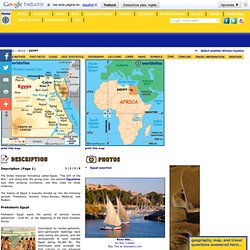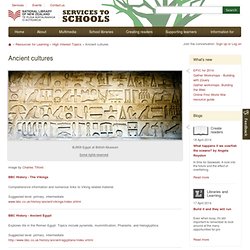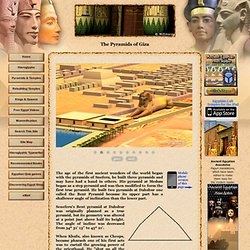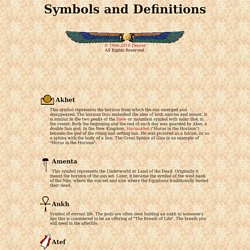

Maps. 1 | 2 | 3 | 4 Description (Page 1) The Greek historian Herodotus called Egypt, "The Gift of the Nile," and along that life-giving river, the ancient Egyptians built their amazing civilization, one they ruled for three millennia.

The history of Egypt is typically divided up into the following periods: Prehistoric, Ancient, Greco-Roman, Medieval, and Modern. Prehistoric Egypt Prehistoric Egypt spans the period of earliest human settlement - 3100 BC, or the beginning of the Early Dynastic Period. Dominated by hunter-gatherers, semi-permanent dwellings were used during this period, and the development of tools reached Egypt during 40,000 BC. Desertification forced early Egyptians to settle around the Nile, and adopt a more permanent and sedentary lifestyle around 6,000 BC. The foundation of Dynastic Egypt was laid between 3500 to 3200 BC, as city dwellers began mass-producing mud bricks to build their cities, instead of reeds.
Ancient Egypt Description continued... Ancient Cultures. Image by Charles Tilford BBC History - The Vikings Comprehensive information and numerous links to Viking related material.

Suggested level: primary, intermediatewww.bbc.co.uk/history/ancient/vikings/index.shtml BBC History - Ancient Egypt Explores life in the Roman Egypt. Suggested level: primary, BBC Schools - Ancient Greece Cartoons and comics add to the fun of learning about aspects of life in Ancient Greece. Suggested level: primary, intermediatewww.bbc.co.uk/schools/ancientgreece/main_menu.shtml BBC Schools – Ancient Rome. Encyclopedia - Britannica Online Encyclopedia.
Egyptian Pyramids and Temples of Egypt with Maps. The Pyramids of Giza in Egypt. The age of the first ancient wonders of the world began with the pyramids of Sneferu, he built three pyramids and may have had a hand in others.

His pyramid at Medum began as a step pyramid and was then modified to form the first true pyramid. He built two pyramids at Dahshur one called the Bent Pyramid because its upper part has a shallower angle of inclination than the lower part. Seneferu's Bent pyramid at Dahshur was originally planned as a true pyramid, but its geometry was altered at a point just above half its height. The angle of incline was decreased from 54º 31' 13'' to 43º 21'.
When Khufu, also known as Cheops, became pharaoh one of his first acts was to curtail the growing power of the priesthood. Khufu's pyramid at Giza showing the plan of passages and burial chamber. Some believe that his pyramid at Giza was built by slaves but this is not true. There are three pyramids at Giza, each of which once had an adjoining mortuary temple. Hieroglyphs 2 - Android >> Housing - Ancient Egypt. There are no forests in Egypt so wood is scarce and is not used for house building.

The earliest inhabitants of Egypt lived in huts made from papyrus reeds. However, it was soon discovered that the mud left behind after the annual flooding of the Nile (inundation) could be made into bricks which could be used for building. Bricks were made by mixing mud and straw and leaving them to dry in the sun. The houses of the poorest people used one row of bricks while those that were not so poor used two or three rows. Although mud brick houses were relatively cheap to make, they were not very strong and began to crumble after a few years.
The houses of the richest people were stronger because they could afford to build their home from stone. Most houses had at least three rooms and all houses had flat roofs which formed part of the living area. Egyptian Make Up. Egyptian Symbols and Definitions. Djed It is believed that the Djed is a rendering of a human backbone.

It represents stability and strength. It was originally associated with the creation god Ptah. Himself being called the "Noble Djed". As the Osiris cults took hold it became known as the backbone of Osiris . Djew Which means mountain, the symbol suggests two peaks with the Nile valley in the middle. Feather of Maat Represents truth, justice, morality and balance. Fetish of Osiris An animal skin hanging from a stick, this is a symbol of Osiris and Anubis. Flail and Crook A symbol of royalty, majesty and dominion. Heb The heb glyph represents an alabaster bowl. Heb-Sed.